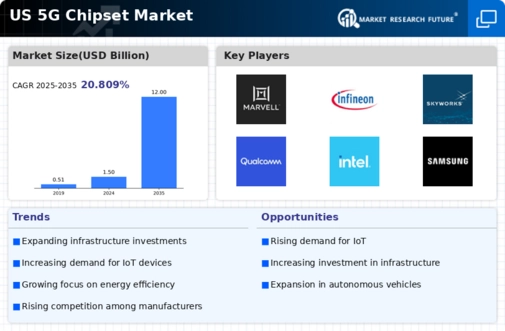Surge in IoT Device Adoption
The rapid adoption of Internet of Things (IoT) devices is significantly influencing the 5g chipset market. As more devices become interconnected, the demand for chipsets that can handle the increased data traffic and provide reliable connectivity is paramount. In the US, it is estimated that the number of connected IoT devices will exceed 30 billion by 2025, creating a substantial market for 5g chipsets. These chipsets are designed to support a variety of applications, including smart home devices, industrial automation, and healthcare solutions. The ability of 5g technology to support massive device connectivity with low latency and high reliability makes it an attractive option for manufacturers looking to capitalize on the growing IoT ecosystem. Consequently, this trend is likely to drive innovation and competition within the 5g chipset market.
Expansion of 5G Infrastructure
The ongoing expansion of 5G infrastructure in the US is a primary driver for the 5g chipset market. As telecommunications companies invest heavily in building out their networks, the demand for advanced chipsets that can support higher data rates and lower latency increases. According to industry reports, investments in 5G infrastructure are projected to reach approximately $275 billion by 2025. This surge in infrastructure development necessitates the deployment of sophisticated chipsets, which are essential for enabling seamless connectivity and supporting a wide range of applications, from IoT devices to autonomous vehicles. The growth of smart cities and connected environments further amplifies the need for robust 5g chipsets, as they play a critical role in facilitating real-time data exchange and enhancing overall network performance.
Increased Mobile Data Consumption
The continuous rise in mobile data consumption is a significant driver for the 5g chipset market. As consumers increasingly rely on mobile devices for streaming, gaming, and other data-intensive applications, the demand for faster and more efficient chipsets becomes critical. Reports indicate that mobile data traffic in the US is projected to grow at a compound annual growth rate (CAGR) of over 30% through 2025. This surge in data consumption necessitates the development of 5g chipsets that can support higher bandwidth and improved network efficiency. Manufacturers are focusing on creating chipsets that not only enhance user experience but also optimize energy consumption, thereby addressing the growing concerns regarding sustainability in technology. The interplay between rising data demands and chipset innovation is likely to shape the future landscape of the 5g chipset market.
Government Initiatives and Funding
Government initiatives aimed at promoting 5G technology are playing a crucial role in shaping the 5g chipset market. Federal and state governments in the US are increasingly recognizing the importance of 5G for economic growth and technological advancement. Initiatives such as the National Telecommunications and Information Administration's (NTIA) programs are designed to facilitate the deployment of 5G networks and enhance broadband access. Additionally, funding opportunities for research and development in 5G technologies are becoming more prevalent, encouraging innovation in the chipset sector. The allocation of public funds to support 5G infrastructure projects is expected to exceed $100 billion over the next few years, thereby stimulating demand for advanced chipsets that can meet the requirements of next-generation networks.
Emergence of New Applications and Services
The emergence of new applications and services enabled by 5G technology is driving growth in the 5g chipset market. Industries such as healthcare, automotive, and entertainment are exploring innovative use cases that leverage the capabilities of 5G, including augmented reality, virtual reality, and real-time remote monitoring. As these applications gain traction, the demand for specialized chipsets that can support their unique requirements is expected to rise. For instance, the automotive sector is increasingly integrating 5G technology for connected vehicles, which require advanced chipsets to facilitate communication between vehicles and infrastructure. This trend is likely to create new revenue streams for chipset manufacturers and stimulate competition within the market, as companies strive to develop cutting-edge solutions that cater to the evolving needs of various industries.

















Leave a Comment